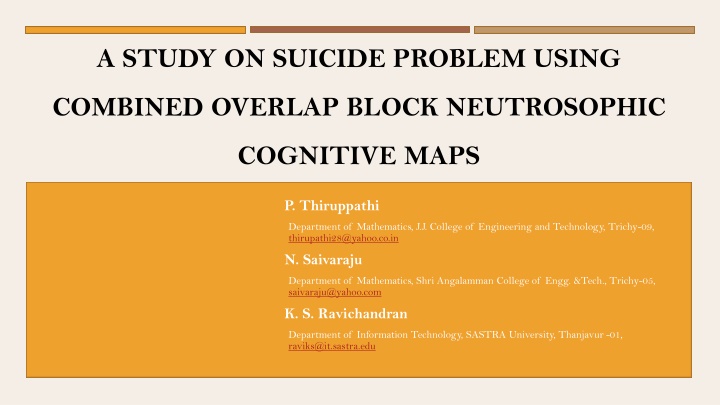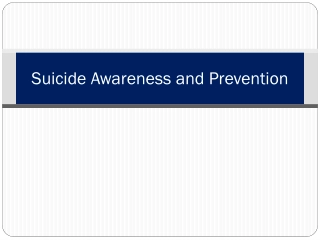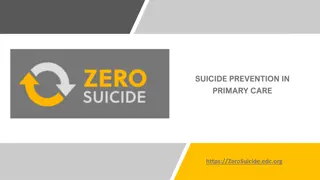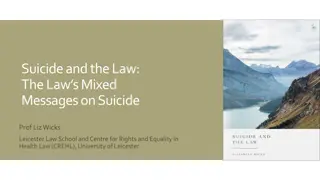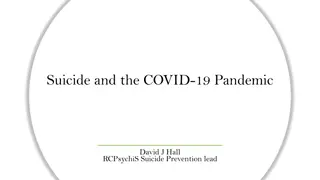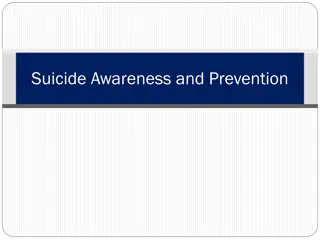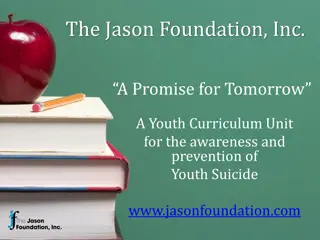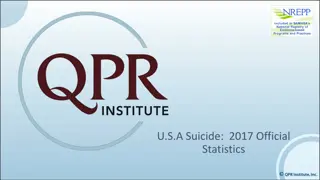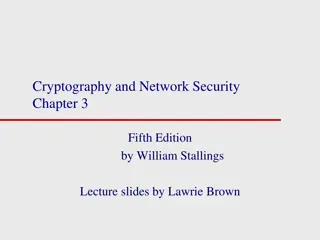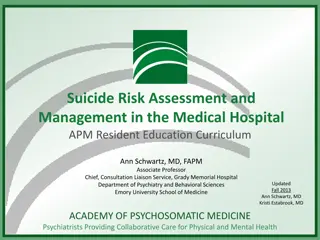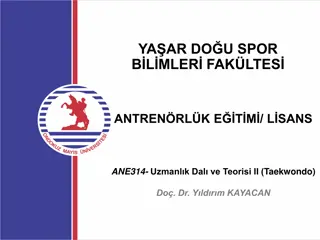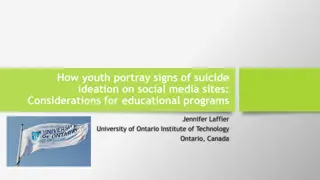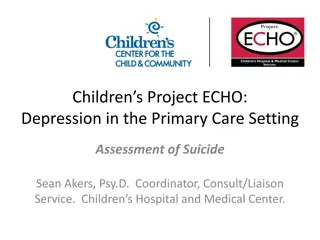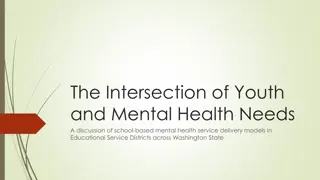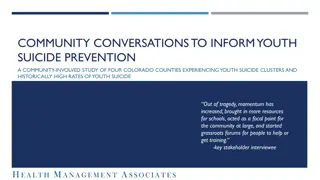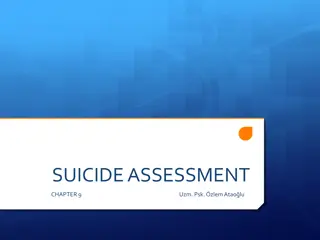A Study on Suicide Problem Using Combined Overlap Block Neutrosophic Cognitive Maps
This study delves into the complex issue of suicide using combined overlap block neutrosophic cognitive maps. The research, conducted by Thiruppathi from the Department of Mathematics at J.J. College of Engineering and Technology in Trichy-09, offers valuable insights into this critical area of study. By employing innovative techniques and methodologies, the study aims to enhance our understanding of the factors influencing suicide and contribute towards meaningful interventions and prevention strategies.
Download Presentation

Please find below an Image/Link to download the presentation.
The content on the website is provided AS IS for your information and personal use only. It may not be sold, licensed, or shared on other websites without obtaining consent from the author.If you encounter any issues during the download, it is possible that the publisher has removed the file from their server.
You are allowed to download the files provided on this website for personal or commercial use, subject to the condition that they are used lawfully. All files are the property of their respective owners.
The content on the website is provided AS IS for your information and personal use only. It may not be sold, licensed, or shared on other websites without obtaining consent from the author.
E N D
Presentation Transcript
A STUDY ON SUICIDE PROBLEM USING COMBINED OVERLAP BLOCK NEUTROSOPHIC COGNITIVE MAPS P. Thiruppathi Department of Mathematics, J.J. College of Engineering and Technology, Trichy-09, thirupathi28@yahoo.co.in N. Saivaraju Department of Mathematics, Shri Angalamman College of Engg. &Tech., Trichy-05, saivaraju@yahoo.com K. S. Ravichandran Department of Information Technology, SASTRA University, Thanjavur -01, raviks@it.sastra.edu
Abstract. The autors study to find out reasons for suicide using Overlap Block Neutrosophic Cognitive Maps (COBNCMs) defined by Florentin Smarandache and W. B. Vasantha Kandasamy. The Combined Overlap Block Neutrosophic Cognitive Maps defined in this method becomes effective when the number of concepts can be grouped and are large in numbers. This presentation has three sections. The first and second sections recall the fundamentals of Neutrosophic Cognitive Maps (NCMs), Combined Block Neutrosophic Cognitive Maps (CBNCMs), and Combined Overlap NCMS, respectively. The third section gives the adaptation of Overlap NCM to the problem.
I. Fundamentals of Neutrosophic Cognitive Maps (NCMS) and Overlap Block NCMs. Definition 1.1 Neutrosophic Cognitive Map is the generalization of Fuzzy Cognitive Map. A Neutrosophic Cognitive Map (NCM) is a neutrosophic directed graph with concepts like policies, events etc. as nodes and causalities or indeterminates as edges. It represents the causal relationship between concepts. Definition 1.2 NCMs with edge weight from {-1, 0, 1, I } are called simpleNCMs.
Definition 1.3 Let C1, C2, ., Cnbe the nodes of a NCM. Let the neutrosophic matrix N(E) be defined as N(E) = (eij) where eijis the weight of the directed edge Ci Cj, where eij {0, 1, -1, I}. N(E) is called the neutrosophic adjacency matrix of the NCM. Definition 1.4 Let C1, C2, ., Cnbe the nodes of the NCM. Let A = (a1, a2, ., an) where ai {0, 1, I}. A is called the instantaneous state neutrosophic vector and it denotes the ON , OFF , INDETERMINATE state position of the node at an instant, ai = 0 if ai is off (no effect) ai = 1 if ai is on (has effect) ai = I if aiis indeterminate (effect cannot be determined), for i = 1, 2, ., n.
Definition 1.5 Let C1, C2, ., Cnbe the nodes of the FCM. Let C1C2, C2C3, , Cn-1Cn, be the directed edges of the NCM. Then the edges form a directed cycle. A NCM is said to be cyclic if it possesses a directed cycle. A NCM is said to be acyclic if it does not possess any directed cycle. Definition 1.6 A NCM with cycles is said to have a feedback. When there is a feedback in the NCM, i.e. when the causal relations flow through a cycle in a revolutionary manner, the NCM is called a dynamical system.
Definition 1.7 Let C1C2, C2C3, , Cn-1Cn, be the directed cycle, when Ci is switched on and if the causality flow through the edges of a cycle and if it again causes Ci, we say that the dynamical system goes round and round. This is true for any node Ci, for i = 1,2, ., n. The equilibrium state for this dynamical system is called the hidden pattern. Definition 1.8 If the equilibrium state of a dynamical system is a unique state vector, then it is called a fixed point. Consider the NCM with C1, C2, ., Cnas nodes. For example, let us start the dynamical system by switching on C1. Let us assume that the NCM settles down with C1 and Cnon, i.e. the state vector remain as (1,0, 0, 1). This neutrosophic state vector (1,0, 0, 1) is called the fixed point.
Definition 1.9 If the NCM settles with a neutrosophic state vector repeating in the form then this equilibrium is called a limit cycle of the NCM. Definition 1.10 Let P be the problem under investigation. Suppose let {C1, C2, ., Cn} be n concepts associated with P (n very large). Now divide the number of concepts {C1, C2, ., Cn} into classes S1, ..., Stwhere the classes are such that
Now we obtain the NCM associated with each of the classes S1, , St. We determine the relational matrix associated with each Si. Using these matrices we obtain a n n matrix. This n n matrix is the matrix associated with the Combined Overlap Block NCM (COBNCM) of blocks of same sizes. Definition 1.11 Finite number of NCMs can be combined together to produce the joint effect of all NCMs. If N(E1), N(E2), ., N(Ep) be the neutrosophic adjacency matrices of a NCM with nodes C1, C2, ., Cnthen the combined NCM is got by adding all the neutrosophic adjacency matrices N(E1), ., N(Ep). The combined NCMs adjacency neutrosophic matrix is denoted by N(E) = N(E1) + N(E2)+ + N(Ep).
II. Problem definition and Justification for using Overlap Block NCM Model. Suicide is one of the leading cause of death in the world. Suicide is defined as deliberate killing of oneself. The purpose of study is to identify the risk groups. Suicides are most likely to occur during the periods of socio economic, family and individual crisis. Suicide prevention is an umbrella term for the collection of efforts of local citizen organizations, mental health practitioners and related professionals to reduce the incidence of suicide through the preventive and proactive measures. Moreover the data is an unsupervised one and also there is uncertainty and indeterminacy in the concepts. Hence, Neutrosophic tool alone has the capacity to analyze these concepts.
III. Adaption of Overlap Block NCM to the problem. Using the linguistic questionnaire and the experts opinion we have taken the following eight concepts {C1, C2, ..., C8}. The following concepts are taken as the main nodes for our problem. C1 Poverty and unmanageable living cost (Economic Crisis). C2 - Working hours more with poor salary. C3 - Lack of commitment from the breadwinners. C4 Failure in business. C5 Inability to deal with debt trap and torture from kanduvattikarars (usurers). C6 Government indifferences. C7 Stress from mental, sexual and physical torture in the working places. C8 Lack of counselors to help persons out of depression.
Now we proceed on to apply the effect of combined overlap block NCM of equal length. Let us consider the eight concepts {C1, C2, ..., C8}. We divide these concepts into cyclic way of classes, each having just four concepts in the following way. The directed graph and the relation matrix for the class S1 = {C1, C2, C3, C4} given by the expert is as follows.
The directed graph and the relation matrix for the class S2 ={C3, C4, C5,C6} given by the expert is as follows. The directed graph and the relation matrix for the class S3= {C5, C6, C7 , C8} given by the expert is as follows.
The directed graph and the relation matrix for the class S4 ={C7, C8, C1, C2}. given by the expert is as follows. The combined directed graph and combined overlap block NCM of equal sizes is as follows.
Now using the matrix A of the Combined overlap block NCM, we determine the hidden pattern. Suppose the concept C1 is in the ON state and all the nodes are in the OFF state. Let the initial input vector be X = (0 0 0 0 0 0 0 1 ), where Lack of counselors to help persons out of depression is taken as the ON state and all other nodes are in the OFF state. The effect of X on the dynamical system A is given by: where point. denotes the resultant vector after thresholding and updating, X4 is the hidden pattern, which is the fixed
CONCLUSION. While analyzing NCM, when the concept C8, Lack of counselors to help persons out of depression , is in the ON state, the other concepts C1, C2, C5, C6, C7are in the ON state, C3 is in the OFF state, and at the same time C4 is in indeterminate state, i.e. when there is Lack of counselors to help persons out of depression , there will be Poverty and unmanageable living cost (Economic Crisis), Working hours - poor salary, Inability to deal with debt trap and torture from kanduvattikarars (usurers), Government indifferences, Stress from mental, sexual and physical torture in the working places and also there may be business failure. Therefore Lack of counselors to help persons out of depression is the major reason for the suicide; individuals can be helped out from stress, thereby avoid suicide.
REFERENCES 1. Kosko, B., January, 1986, Fuzzy Cognitive Maps , International journal of man-machine studies, pp.62-75 2. Vasantha Kandasamy and Smarandache Florentin, 2004, Analysis of social aspects of migrant labourers living with HIV/AIDS using Fuzzy Theory and Neutrosophic Cognitive Maps , Xiquan, Phoenix. 3. Vasantha Kandasamy W.B. and Victor Devadoss A., 2004, Some New Fuzzy Techniques , Jour. of inst. of Math. & Comp. Sci. (Math.ser.), Vol. 17, No.2 (pp.157-160. 4. How bonded labourer in rice mills suffer , The New Indian Express, Aug 21, 2004; and Thinathanthi, October 2004. 5. Rich Tirupur is India s Suicide Capital , Deccan Chronicle, July 23, 2010.
